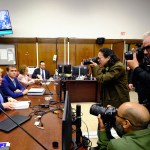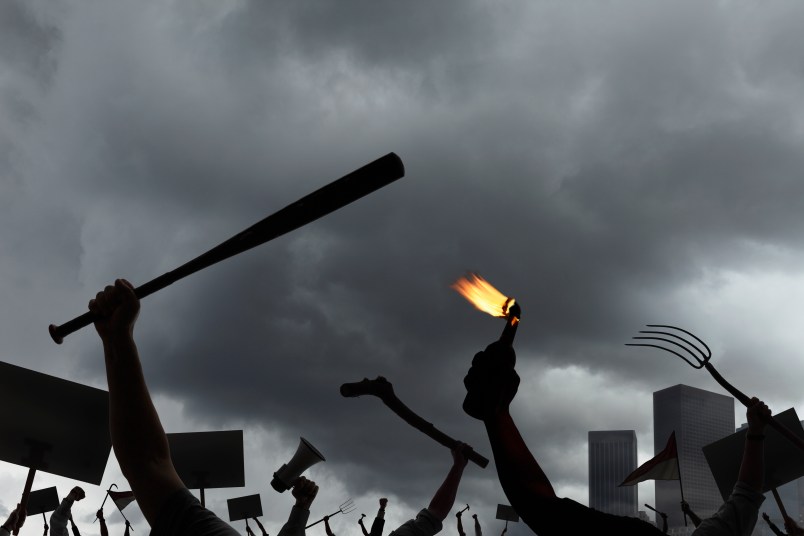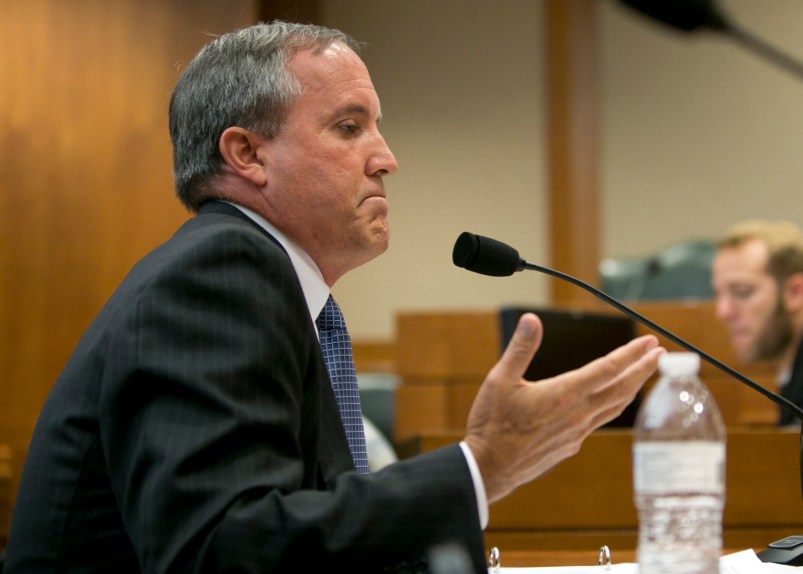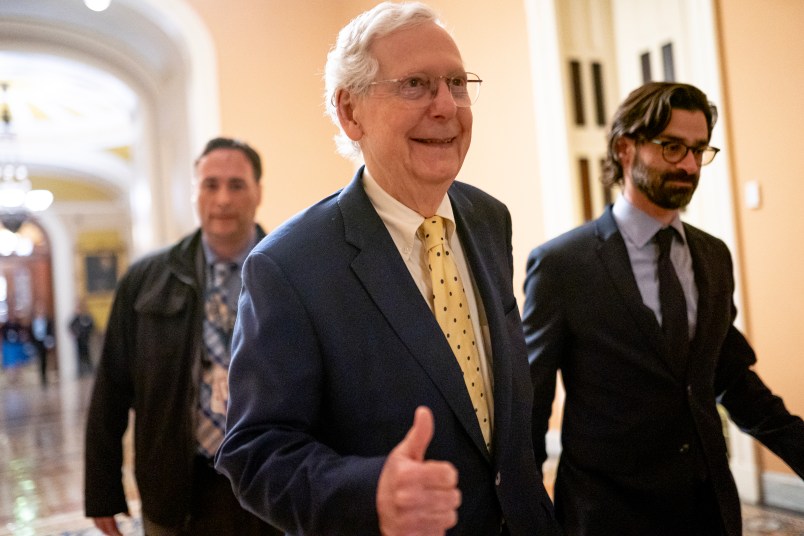When we first met, at the start of 2014, Donald Trump was already quite sure he would seek the presidency of the United States. He offered two reasons. First was his antipathy toward President Obama, whom he had spent years trying to delegitimize with absurd questions about his citizenship. (“There’s so much about him that’s a lie,” Trump later told me.) Second was his confidence in the encouragement he received from social media. He noted that every day he heard from Twitter followers who were encouraging him to run and this support represented, in his mind, the pulse of the people.
In the year that followed our first encounter, Trump and I met periodically in his penthouse apartment atop the towering building he named for himself. On every occasion he delivered a diatribe against Obama and shared his views on human nature and political leadership. He considers humans rather untrustworthy and prefers cheerleader politicians. Although he never got beneath the surface in his analysis of any policy, Trump was clearly attuned to the art of campaigning which, in our media saturated age, aligns with his area of expertise: the marketing of the human brand called Trump.
Delve deeply into the Trump story and you discover that he has been working on his own hybrid of politics and self promotion for almost thirty years. He is not, like Ben Carson, a true outsider and he has never been a consistent conservative. However he has always been the kind of cheerleader who reliably boosts himself and turns the other side, be it a competing candidate or a foreign country, into an enemy.
“Mostly driven by ego, some driven by greed, most driven by both.”
— Donald Trump on the motivations of politicians
For six years Donald Trump failed to make the Forbes magazine list of America’s four hundred richest people. Limited by the data available, and because some people prefer to keep their wealth private, the list has never been a perfect representation of the richest slice of America. But no other source had kept a running tally of individual fortunes for so long, which meant that the publication of the list was widely anticipated and announced in the press around the world. For some among the four hundred, the publication became an annual rite of affirmation. It demonstrated to one’s peers, and the entire world, just how well you measured up. This explained why Donald Trump regularly contacted the magazine’s editors to say that he should be included when he was not, or that his fortune was bigger than they reported.
Trump’s exile ended in 1996, when Forbes pegged his net worth at $450 million, which made him number 373. Nevertheless, he called the editors to complain that his worth was much bigger: “I’ve got that much in stock market assets alone.” In 1997 he returned to the billionaires’ club—$1.4 billion—and almost cracked the top 100. Still he wasn’t satisfied: “The real number is $3.7 billion.” The pattern continued for the next couple of years. In 1999 he said the Forbes estimate of $1.6 billion was off by almost $3 billion. “We love Donald,” said the Forbes editors. “He returns our calls. He usually pays for lunch. He even estimates his own net worth ($4.5 billion). But no matter how hard we try, we just can’t prove it.”
Forbes struggled with Trump’s score because much of his wealth was privately held and not subject to independent audits to confirm the balance between his assets and his liabilities. Also, any measure of Trump’s wealth depended on estimates of the value of his real estate holdings. Unlike stocks and bonds, which are traded at posted prices, buildings and vacant land are not plastered with price tags. Their value depends on what a buyer will pay, and no one can predict the figure until a purchase is made.

Trump chronicled how he returned from near bankruptcy to a personal net worth estimated at $1.4 billion by Forbes Magazine in his book, The Art of the Comeback.
Still, the editors at Forbes knew that by concentrating on the highest end of the market, in one of the world’s most expensive cities, Trump had made a wise bet. With every year Manhattan attracted more of the world’s wealthiest people, who sought to live in luxury apartments. This demand ratcheted up the value of real estate, which motivated developers, who purchased properties that once served middle-class New Yorkers and turned them into expensive housing. Manhattan’s gentrification was aided by city officials, who envisioned greater tax revenues with each new development.
As this process took hold, the share of affordable, rent-controlled apartments declined, which sent the poor and the middle class to the outer boroughs. Those who criticized this trend noted that incoming whites were pushing black and Hispanic residents out and Manhattan was starting to resemble a high-rise suburb. For Trump, who only had to maintain his properties to see them increase in value, this gentrification brought almost magical returns on his investments as, every year, the borough of Manhattan became more exclusive.
The value of Trump’s real estate was subject to interpretation. However, the performance of Trump Hotels and Casino Resorts, which included all of his gambling properties and required active day-to-day management in a highly competitive market, was plain to see in its stock price. Every year, as Trump’s fortunes rose, the stockholders in his public company suffered. In September 1999, as Donald Trump claimed he was vastly more wealthy than others recognized, a share of the stock traded under the man’s initials could be had for a mere $4.44.
All casino stocks declined in value in the same period, but DJT was hit especially hard as the company failed to meet Trump’s predictions for big revenue gains.
Trump’s performance when it came to running a public company led to talk about how his name, which supposedly boosted the value of real estate, had the opposite effect on stocks. This “Donald discount” meant that traders shaved the price to compensate for the difference between his hype and his results. In March of 1997, Steve Ruggiero, an analyst for Chase securities, said “[t]he biggest problem is they aren’t forthcoming with all the analysts…It raises suspicions.”
Suspicion may also have been fueled by occasional reports of improprieties committed by Trump the man, and his companies. In early 1998, the casino operation paid a $477,000 fine to the U.S. Treasury for failing to submit timely reports on currency transactions, as required by regulations that were intended to prevent money laundering by criminals. In 2000, Trump and his associates would pay $250,000 to settle the State of New York’s claim that they failed to disclose that they had secretly financed advertisements against the development of casinos in the Catskill Mountains region. A full $50,000 of this fine was paid by Trump Hotels and Casino Resorts. The agreement provided that there was no admission of wrongdoing on Trump’s part.
Among the associates who were also fined in the connection with this scheme was Roy Cohn acolyte Roger Stone, who once summed up his methods in a conversation with New Yorker writer Jeffrey Toobin by saying, “Attack, attack, attack—never defend” and “Admit nothing, deny everything, launch counterattack.” In general, Stone’s attacks were intended to persuade voters that the GOP, which was traditionally the party of big business and the country-club set, was actually the anti-elite party of the working class. To do this he played on many Americans’ discomfort with intellectuals (the elite Stone opposed) and their appreciation for those who succeeded in the economic marketplace.
In this calculus wealth equaled virtue, and thus anyone who defended business or proved himself a success as an entrepreneur was worthy of support. This formula produced what writer Thomas Frank called “market populism,” which melded aspects of pop culture, patriotism, and pro-business ideology into a belief system that blamed most of the country’s problems on government and intellectuals, especially those who could be called politically liberal. At GOP rallies and on Fox News network programs, the enemy sometimes included labor unions and anyone else who might oppose those who would amass enormous fortunes as businesspeople or financiers. Millions of Americans embraced this view, including many who were themselves falling out of the middle class as wealth became ever more concentrated at the top.
Although Stone was able to articulate market populism and design campaigns to exploit it, Donald Trump understood it viscerally. Eager to identify with those who were wary of social and intellectual elites, he talked about how he preferred meat and potatoes to haute cuisine and disdained high-society events. Always ready to push the bounds of propriety, Trump also pandered to the prejudices that arise out of fear.
When he said, “If I were starting off today, I would love to be a well-educated black because they have an actual advantage,” Trump touched directly on the insecurities of whites who were struggling to keep up in a Darwinian economy. In 1989, when he made this remark, few white men would choose to be black. Some did, however, resent both affirmative action programs, which were created to redress historical discrimination, and school integration efforts that affected their families while exempting those who could afford to send their children to private school. Trump cut through the complexities of these issues, appealing to white grievance and forgoing a sophisticated understanding of race in his time.
But while Trump occasionally promoted his views on race and social class, he constantly dwelled on his own success. He would confess that he had struggled in some aspects of his personal life, but would also draw attention to the many beautiful women he had known as proof that he was an impressive man. In another place or time, this kind of talk would be dismissed as crass and self-defeating. But in Trump’s time, self-promotion had become an acceptable if not essential part of everyday life.
With the advent of the Internet and then social networking sites such as Facebook, individuals in all walks of life developed sophisticated, brochure-ready versions of themselves based on flattering pictures, tales of their impressive exploits, and reports on their latest purchases. Sizing up the end of the twentieth-century, an NBC TV executive with a doctorate in sociology said that superficiality had triumphed over substance. “All the stuff our parents told us didn’t come true,” said Rosalyn Weinman, PhD. “No one cares if you’re good. People only care if you’re good-looking and rich.”
Having won the attention of the press and public as a rich and good-looking man, Donald Trump continually sought to keep it. To stay good-looking he battled against middle-age weight gain, wore a uniform of expensive suits, and devoted great effort to keeping his hair. “The worst thing a man can do is let himself go bald,” he had once told casino executive Mark Estess. “Never let yourself go bald.” As he said this, Trump gave Estess a tube of cream that supposedly stopped the progress of hair loss. The cream was just one part of the Trump campaign against baldness. In his book Lost Tycoon, writer Harry Hurt described a surgical procedure that had closed the bald spot on the back of Trump’s head.

An audience member checks to see if Trump’s hair is real during a 2016 campaign event.
Trump denied he underwent surgery for hair loss, but beginning around 1990 his coif became the subject of frequent speculation in the press. Once a helmet of brown, it became an extravagant complex of reddish-gold swirls and parts that included swooping strands that moved from one side of his head to the other, and others that went from back to front. All this effort led Time magazine to consult a stylist and publish a diagrammed account of how it was done. Presented under the headline “The Secret to Donald Trump’s Hair,” the graphic showed how a man’s hair, grown long in the back, could be combed forward, then swept back and fixed with spray. Captions warned, “Don’t confuse this with a classic side-part comb over,” and referenced the dramatic styles of cartoon character Wilma Flintstone and real-life talk-show host Conan O’Brien, whose unruly, red waves resembled breaking surf.
Trump was a good sport about the hair commentary. On occasion he would invite an interviewer to examine his head to see if it was real. But the media’s fascination with Trump’s hair didn’t revolve around the question of whether it was real. What was significant was what it said about his audacious vanity. In his mind, going bald was a greater shame than the confection atop his head. In time, his hair would become such a distinguishing feature that costume makers would sell Trump wigs for Halloween.
As a man who craved attention, Trump was unable to change his hairstyle because it got him noticed, and there was almost nothing he wouldn’t do for attention. In 1999 he went so far as to renounce his membership in the Republican Party and engage in an extended flirtation with the Reform Party of the United States of America, which was preparing to field a candidate in the 2000 presidential election.
As Trump began his political whirl, he turned to Roger Stone, the onetime dirty trickster, to direct what was called an “exploratory” committee. These organizations allowed anyone who thought he or she might want to run to act like a candidate and solicit the attention of the press and public, without committing to a process that could be won or lost on the basis of actual votes. Exploratory activities were like the pitches thrown by a fastballer warming up for the game. Fans might ooh and aah at the sound of the ball popping into the catcher’s mitt, but it didn’t count until the umpire cried, “Play ball!”

Trump tells Larry King that he has formed an exploratory committee in 1999.
One could have said that Reform Party process was basically an exhibition that would amount to little more than an outlet for the frustrations of those who believed, more as a matter of faith than fact, that Bill Clinton had won election as president because his GOP opponents were insufficiently conservative. A legacy of businessman Ross Perot’s failed 1992 and 1996 presidential campaigns, the Reform Party was so small and disorganized that it stood no chance of winning a national election. Perot’s showings had, however, qualified it for more than $12 million in federal aid in the 2000 campaign. This money was a lure for consultants, who would enjoy a bit of cash flow if they were hired to conduct polls, craft strategies, or develop campaign advertisements. But no independent political expert would give the party any chance of playing more than a spoiler’s role in the 2000 presidential race.
The party’s one real claim to success had been the election of former pro wrestler Jesse “the Body” Ventura as governor of Minnesota in 1998. Yet Ventura’s election was more a matter of his celebrity than his Reform Party affiliation, which he underscored when he left the group during his first year in office. Some in the Reform Party hoped to woo him back, but as the 2000 election approached, the Body declined to seek its presidential nomination. His decision left the field open to others, including the longtime Republican activist Patrick Buchanan, who claimed a “peasant army” would support him. Like Roger Stone, Buchanan was a Nixon alumnus with rather extreme views. His inflammatory comments about the Holocaust, for example, had earned him the label “unrepentant bigot” from the Jewish Anti-Defamation League.

Trump greets Minnesota Gov. Jesse Ventura in 2000.
Buchanan, who had mounted two previous failed attempts to win the GOP nomination, framed his campaign for the Reform Party nod as a matter of principle, saying that he represented the true conservatism that the Republicans had abandoned. Anti-abortion and isolationist in his foreign policy, Buchanan was driven by his desire to get a hearing for his ideas, some of which were consistent with those Perot had advanced as the Reform Party’s first standard-bearer. With his campaign, Buchanan got what he wanted as voters attended his speeches, reporters wrote articles about his views, and TV producers invited him to appear on national programs such as Meet the Press, Face the Nation, and Fox News Sunday.
Trump received the same kind of attention after he joined the party in the fall of 1999 and said he was considering a run for the Reform Party nomination. His views were less refined and detailed than those offered by Buchanan, who had spent decades in politics. Trump also expressed some ideas that would have appealed to mainstream Americans but were anathema to many Reform Party stalwarts. For example, Trump said the Republicans had “moved too far toward the extreme right” and that he was capable of capturing more than the “really staunch-right wacko vote” by reaching middle-of-the-road Americans. But the core of the Reform Party was “staunch right,” and Trump would never win the party’s nomination by veering left. He did make himself more visible with every appearance in the press, where his audience could be rewarded with outrageous statements:
On Buchanan: “He’s a Hitler lover; I guess he’s an anti-Semite. He doesn’t like the blacks, he doesn’t like the gays.”
On Cuba: Fidel Castro is “a killer and should be treated as such.”
On his ideal running mate: Oprah Winfrey because “she’s popular, she’s brilliant, she’s a wonderful woman.”
On candidates who are proud of their humble backgrounds: “They’re losers. Who the hell wants to have a person like this for president?”
In the amalgamation that was his platform, Trump included items from the left side of the political menu, including a big, onetime tax on the rich to trim the federal deficit, a policy to allow gay soldiers in the military, and universal employer-based health insurance with subsidies for the poor. Reports on his campaign tended to dwell more on the idea of his candidacy rather than on the ideas he would advocate. Quoted as Trump’s campaign manager, Roger Stone made much of how Trump possessed a list of 6.5 million names and addresses, thanks to the record keeping at his casinos and hotels. Stone also celebrated that his man came in second to George W. Bush in a poll of voter preferences.
The survey was cited by Trump as evidence of a groundswell of support, which, he said, prompted him to form a campaign committee to advise him on a run. He did not make public the names of those who would advise him, and the poll, which was conducted by the less-than-authoritative National Enquirer tabloid, surveyed just one hundred people in a land of 280 million. Nevertheless, Trump said that he believed he had “huge” public support. He also noted that he en- joyed two great advantages over other candidates: first, he was extremely well-known, and second, he was extremely rich, which meant he could pay for his own campaign and forgo the effort and obligations that come with soliciting donations.
In 2000 Forbes estimated Trump’s wealth at $1.7 billion, which made him the 167th richest man in America. The magazine explained that Trump believed he was worth “more than $5 billion” but “back on earth” his fortune was “considerably less.” Trump’s view of his political capital was similarly inflated. Though he claimed to enjoy broad voter support, a Quinnipiac University poll that found that roughly nine out of ten New Yorkers, the people who knew him best, didn’t think they would vote for him.
With his scattershot platform and talk, candidate Trump evoked not a serious leader but the main character from the movie Bulworth, which premiered the year before his flirtation with the Reform Party. As played by Warren Beatty, suicidal Senator Jay Bulworth careened around his state seeking votes with outspoken abandon, gathering more support with every outrageous statement. His profane, and even racist remarks, were taken as evidence of his sincerity by voters, who had been subject to so much political manipulation that they found his efforts to repel them absolutely magnetic.
Although the fictional Jay Bulworth intended to lose by being offensive and inconsistent, the real Donald Trump hoped to gain as he veered from left to right and denigrated other candidates. (“He’s got a bad way about him,” said Trump of former senator Bill Bradley, who was often mentioned as a presidential contender.) Trump would have had to be delusional to believe he had any more of a chance to be elected than the comedian Pat Paulsen, who had received 921 votes in the 1996 New Hampshire Democratic presidential primary. However, unlike Paulsen, Trump never let on that his campaign was a joke. Instead he presented himself as a serious candidate whose business success qualified him for the highest office in the world. In this way, the Trump-for-president folly may have been the first true pseudo-campaign in the history of the presidency, a determined effort to exploit the political process by a man whose real purpose was profit.
Susan Tolchin, a public policy professor at George Mason University, suggested that the performance was actually a duet that included Buchanan. While they weren’t serious political figures, Tolchin said they could not be entirely dismissed: “I think people are taking them seriously. They are entertainers, a very important part of society today.” As an entertainer Trump was such a game performer that he had pushed himself forward as a candidate less than three weeks after his father’s death. Fred C. Trump died after suffering from Alzheimer’s disease for six years. He was dispatched with a prominent obituary in The New York Times, which called him a “postwar master builder of housing for the middle class.”
The paper also noted that Fred had been “overshadowed in recent years by his son Donald.”
Donald was not interviewed and quoted at the time of his father’s death, but at the end of the year he did offer a comment, albeit a self-referential one, for the annual roundup of obituaries, which the Times published to mark the passing of notable men and women: “I had friends whose fathers were very successful, and the fathers were jealous of the sons’ success and tried to hurt them, keep them down, because they wanted to be the king. My father was the exact opposite. He used to carry around articles.”
Maryanne Trump pointed to her father’s caution and humility. Noting he had never put his name on any of his previous projects, she said her father had to be coaxed to have a sign that announced trump village posted on the big complex he built in Brighton Beach.
As the Reform Party convention drew near, Trump attacked Governor George W. Bush of Texas as inexperienced. He said that he was offering voters a businessman’s “eye for the bottom line,” which was an odd kind of offer, given that his Trump Hotels and Casino Resorts operation was about to post a loss of $34.5 million for the last quarter of 1999. Trump also derided his most likely opponents, Al Gore and Bush, as “Ivy League contenders” without a hint of embarrassment about his diploma from Penn, which was an Ivy League school. He announced that if elected president, he would appoint himself to the post of international trade representative, which would permit him to be addressed as either Mr. President or Mr. Ambassador or, perhaps, Mr. President Ambassador.
Political veterans such as Dick Morris observed that Trump was publishing a new book, The America We Deserve, which might get a boost in sales from the author/candidate’s appearances on TV talk shows such as Larry King Live (CNN), The Early Show (CBS), and the Tonight Show (NBC), which invited him to talk politics. Many of his ideas were dismissed as unworkable. For example, a onetime tax on the rich was labeled “harebrained” by economist and securities analyst David Jones, who said it could cause a stock-market collapse. (A former IRS commissioner called it “wacky, constitutionally.”) A few of Trump’s proposals did show he was both forward-looking and ideologically flexible. Among them was a project to develop and stockpile treatments in anticipation of future pandemics or the use of release of biological agents by terrorists.

Trump signs copies of his 2000 book, “The America We Deserve.”
Always unconventional, Trump didn’t deliver stump speeches to political audiences. It appeared that he made just one traditional campaign-style foray, which brought him to South Florida to speak to Cuban Americans for a day. Otherwise he traveled the country via private jet and pocketed $100,000 per appearance for the business advice he dispensed at seminars, where he shared the stage with Tony Robbins, a janitor turned self-help guru.
Robbins, who in recent years had legal troubles that cost him more than $870,000, organized the Results 2000 speaking tour for himself, Trump, and others he called “the masters of our time.” But while Robbins advertised these events as “seminars,” for which attendees paid as much as $229 apiece for tickets, the Trump exploratory committee described them as “speeches.” On the day of the Results 2000 event in Hartford, Connecticut, a Trump aide told a reporter for the New York Daily News that while others expended great amounts on their campaigns, “Trump is making money running for president.”
When Trump arrived for the Results 2000 event in St. Louis, a reporter for the Post-Dispatch newspaper dutifully noted the big private jet with trump emblazoned on it and informed her readers that the man would be speaking at the nineteen-thousand-seat arena where the local pro hockey team played its games. The crowd heard roughly thirty minutes of Donald’s business advice, much of which could be found in his books, including “Donald’s Rules of Success,” which included “think big” and “be paranoid.”
Tony Robbins offered Norman Vincent Peale updated for a new century. Where Peale emphasized the power of positive thinking, Robbins stressed the use of “trigger” phrases such as “Step up!” and “I’ll do it” to provoke the mind’s power. “We’re not talking confidence,” said Robbins, “we’re talking certainty. It’s a different level.” As Trump dwelled on money, Robbins emphasized power. The word power appeared on many of the products he offered for sale, including a book called Unlimited Power and an audio set called Unleash the Power Within.

Headliners Robbins and Trump were joined by different costars in each city. In St. Louis the crowd heard from retired U.S. Army general Norman Schwarzkopf, who led US and allied forces in America’s first Gulf War in 1990. Widely regarded as a military hero, Schwarzkopf had accepted $5 million for his memoirs and was spending much of his retirement giving well-paid, inspirational speeches to audiences who greeted him with enthusiasm. At the St. Louis event, however, the biggest cheers were reserved for Dick Vermeil, whose honors had been earned in the American sport most closely resembling warfare—football. Vermeil’s St. Louis Cardinals had won the Super Bowl days before the seminar.
After his St. Louis speech, Trump stayed in character as a politician until the middle of February, when he went on television to announce that he was ending his campaign because “the Reform Party is a total mess.” The other side of the story came from Reform Party stalwarts who complained that his campaign had never been serious. They believed that he ran to get people to buy his books, purchase tickets to hear him speak, and drop their cash at his gambling halls. “Donald Trump came in, promoted his hotels, he promoted his book, he promoted himself at our expense, and I think he understands fully that we’ve ended the possibilities for such abuse of our party,” said Patrick Choate, a Reform Party leader.
Trump would admit that his political gambol had been good for his business interests. For example, without his supposed candidacy he would not have drawn press to an airport hangar in St. Louis when he jetted into town to address a crowd of people who had bought tickets to hear him speak about life, business, and the secrets of success.
Not one to leave the measure of his success to anyone else, Trump published an accounting of his experience days after he took himself out of contention. His self-portrait was of a man who was thwarted by the rules and stymied by those in the Reform Party who were so extreme they believed a conspiracy of the powerful ran the country. Trump also took a swipe at Al Gore because he appeared to be tired as he trudged through snowy New Hampshire seeking votes. In contrast, Trump said, “I had enormous fun thinking about a presidential candidacy and count it as one of my great life experiences.”
Excerpted from the new book Never Enough: Donald Trump and the Pursuit of Success, published by St. Marten’s Press. Printed by permission. Buy the book here.









